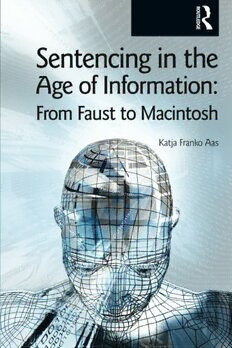Table Of ContentSENTENCING IN
THE AGE OF
INFORMATION:
FROM FAUST TO
MACINTOSH
SENTENCING IN
THE AGE OF
INFORMATION:
FROM FAUST TO
MACINTOSH
Katja Franko Aas
First published in Great Britain 2005 by
The GlassHouse Press, The Glass House,
Wharton Street, London WC1X 9PX, United Kingdom
Telephone: + 44 (0)20 7278 8000 Facsimile: + 44 (0)20 7278 8080
Email: [email protected]
Website: www.cavendishpublishing.com
Published in the United States by Cavendish Publishing
c/o International Specialized Book Services,
5824 NE Hassalo Street, Portland,
Oregon 97213-3644, USA
Published in Australia by The GlassHouse Press,
45 Beach Street, Coogee, NSW 2034, Australia
Telephone: + 61 (2)9664 0909 Facsimile: +61 (2)9664 5420
Email: [email protected]
Website: www.cavendishpublishing.com.au
© Franko Aas, K 2005
All rights reserved. No part of this publication may be reproduced, stored in a
retrieval system, or transmitted, in any form or by any means, electronic, mechanical,
photocopying, recording, scanning or otherwise, without the prior permission in
writing of Cavendish Publishing Limited, or as expressly permitted by law, or under
the terms agreed with the appropriate reprographics rights organisation. Enquiries concerning
reproduction outside the scope of the above should be sent to the
Rights Department, Cavendish Publishing Limited, at the address above.
You must not circulate this book in any other binding or cover
and you must impose the same condition on any acquirer.
British Library Cataloguing in Publication Data
Aas, Katja Franko
Sentencing in the age of information: from Faust to Macintosh
1 Sentences (Criminal procedure)
I Title
345'.0772
Library of Congress Cataloguing in Publication Data
Data available
Paperback ISBN 1-904385-38-9
Paperback ISBN 978-1-904-38538-7
Hardback ISBN 1-904385-39-7
Hardback ISBN 978-1-904-38539-4
1 3 5 7 9 10 8 6 4 2
Printed and bound in Great Britain
For Eva and Maria
Preface
This is a deep book on how we are prevented from going deep.
The book presents a picture of modern judges in modern courtrooms equipped
with computers, electronic information systems, and with sentencing tables that
prescribe the ‘right’ punishment – it simplifies decision-making. Right decisions, or
wrong decisions? Right, if the predetermined procedure is followed correctly; wrong
if the procedure is not followed correctly.
But the deep problems, those Faust wanted to penetrate, those he deposited his
soul to understand, become redundant in this new setting. What is it all for? What
sorts of problems are there to make decisions on? Most importantly: are the decisions
not only technically right, but also morally right? Are they kind? Are they decent – or
wise? These large questions are forced into the background by a situation now defined
in terms of strict rules on how to decide on the base of an assembly of pre-determined
elements.
Maybe the judge has more wisdom than she or he can be programmed for? Maybe
we all have?
The old-fashioned judge in a penal case attempts to understand what sort of
person she or he is facing. Slowly, the judge builds a story of what has happened. To
the judge, and hopefully also to others, this is a comprehensible story; in the best case,
a creation of a piece of art. Through that story, the judge intuitively comes to a
conclusion – the final sentence.
But this is a complicated process – one with many variables at play. It is a process
often based on most of a life on the bench and on experience and intuition. It is also a
story where the outcome, the final sentence, is difficult for politicians and their
managers to control.
Today it appears that all these problems are to be solved through the modern
trend of using sentencing tables or statistical information on the standard sentence.
These pre-determined forms will capture the judge and eliminate discretion, while the
accused will be converted from a whole person in a whole story to a carrier of a risk
configuration according to a grid of pre-determined factors.
But then come the costs: the original meaning of individual was ‘indivisible’ – that
is, something that cannot be divided. Now, it seems, the individual can be divided
into a set of factors. But, thinking of Faust, maybe this is when the devil comes back;
when we are not individuals any more, but only divided parts without souls – parts
that can be handled like parts.
That is what this important book is about.
Nils Christie
Oslo, January 2005
Acknowledgments
I am grateful to a number of people who have contributed in various ways to this
book. In particular, Nils Christie, who provided guidance and inspiration. Grateful
acknowledgments also to the former and present colleagues and students at the
Institute of Criminology and Sociology of Law in Oslo, including Hedda Giertsen,
Ragnhild Hennum, Nicolay Johansen, Heidi Mork Lomell and Lill Scherdin. Helene
Oppen Gundhus has been all one could hope for in a colleague and a friend. I am also
grateful to Craig Calhoun, Thomas Hylland Eriksen and Clifford Shearing for their
inspiring courses, as well as to other participants for the discussions. Further thanks to
Richard Jones, Thomas Mathiesen, Iver B Neuman, Annick Prieur and Jonathan Simon
for their constructive criticism. Different versions of some of the material also
appeared in Punishment & Society, Journal of Scandinavian Studies in Crime Prevention
and The New Punitiveness (edited by John Pratt, David Brown, Simon Hallsworth,
Mark Brown and Wayne Morrison). I am grateful to the editors and the reviewers for
their comments. Norwegian Research Council generously provided the financial
support for the project. Finally, thanks to Beverley Brown and Sanjeevi Perera from
GlassHouse Press for making the book possible.
The mistakes, of course, are mine alone.
Special thanks to my families, Slovenian and Norwegian. First, as always, to Per
Christian, Eva and Maria, and to Iztok and Tanja for their frequent visits and the joy
they brought with them. To my mother and to my grandparents for making me feel I
still had a home with them. And finally, to my father.
Katja Franko Aas
Oslo, January 2005

